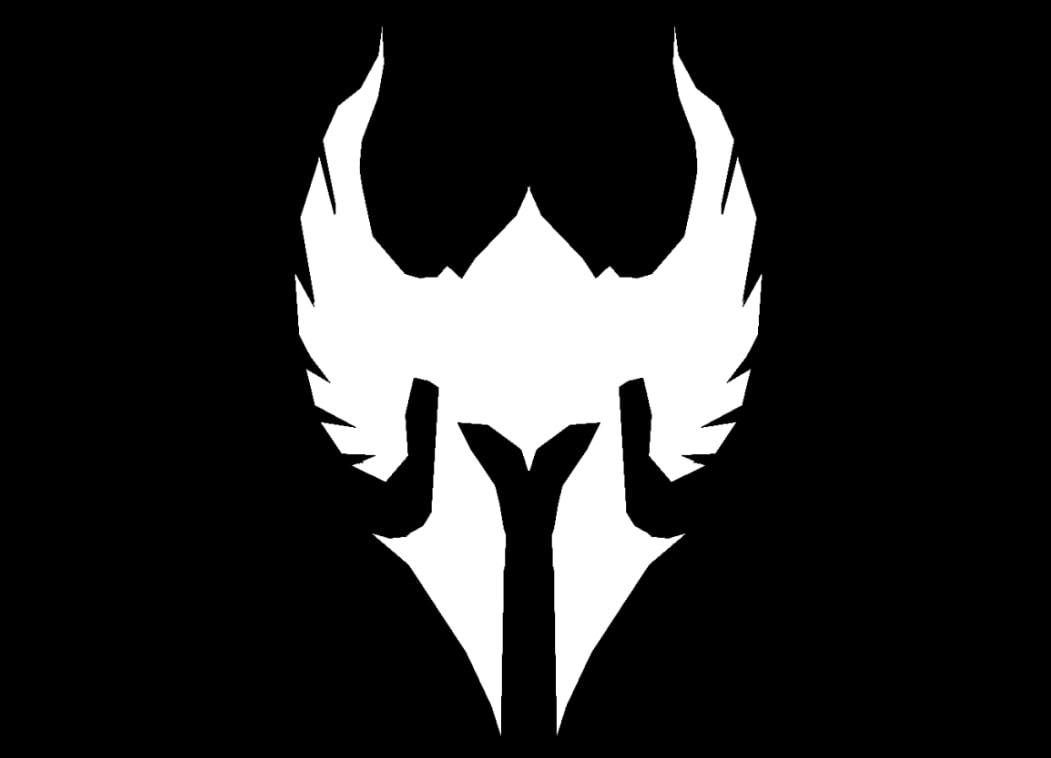
Paladins are a half-caster (a person with access to spellcasting who also has martial abilities. They do not get access to all the levels of spells) class in Dungeons and Dragons. Paladins gain their spellcasting from making an oath, stereotypically to a god, but their oath just has to be strong and dedicated.
Paladin strengths:
- Access to both spellcasting and martial abilities
- Paladins are able to utilize both magic and have effective martial skills like Extra Attack. A combination of these skills makes this class very effective as a combatant
- Higher damage output
- Paladins get an ability called Divine Smite that allows them to use a spell slot to deal extra damage when you make a melee weapon attack. Being able to deal higher damage allows you to manage combat better and easier, and makes them a more optimized combatant
- Innate healing abilities
- Paladins get an ability called Lay on Hands that allows them to touch a creature and restore them hit points from a pool equal to their paladin level x 5. This allows Paladins to provide a support quality as well, making them a more well-rounded class
- Paladins are preparation casters
- Preparation casting allows you to change out your spell list after every long rest (if you so desire), which allows you to adjust your casting if you feel you need to as the campaign changes and allows you flexibility in your casting
- They make for great tanks/front line men
- Paladins have high hit points, strong martial and caster abilities, and proficiency in all armor and shields. This makes them strong and able to take hits, as well as be in the thralls of combat and be able to hold their own
In this article, we'll reveal the best races for the Paladin class.
10) Vulpin (good)
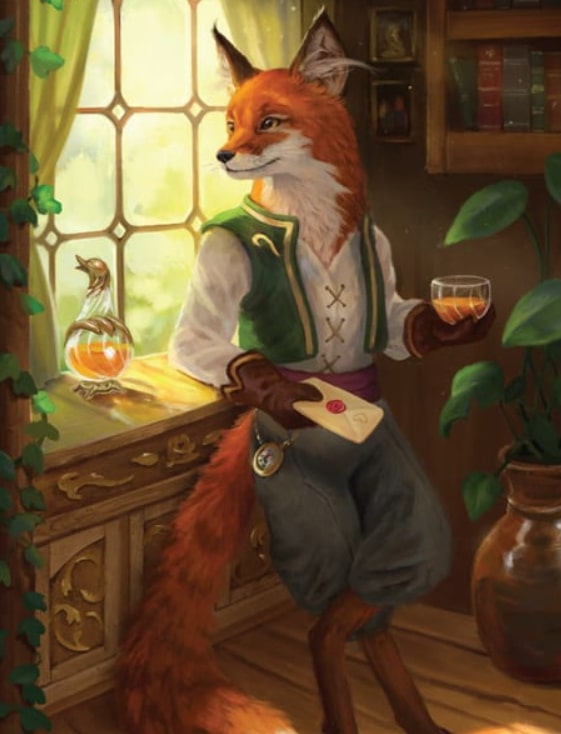
Vulpin are a creature from the Humblewood setting. They are fox-like in appearance, and within their canon lore are often made out to be the villain but are just misunderstood. They have great ambition and sharp wit. Their intense survival instinct can sometimes make them seem selfish, but this does not make them evil. They are charismatic, but rely more on their Intelligence than their Charisma, including for their natural magic. This makes them only slightly compatible for the Paladin class.
Vulpin are only slightly compatible for Paladins. They do get a slight buff to Charisma and have an ability that allows them natural weapons, but they are better for Paladin multiclasses and Intelligence based classes. They are good for increasing damage output, especially when you get Extra Attack, and they increase your spell list, but they are not the most beneficial beyond that.
Choose Vulpin if:
- You want to increase your damage output
- Having a natural weapon that counts as a unarmed strike allows you to increase the damage you can do with an unarmed strike (which is usually 1 + your Strength modifier) and gives you versatility in your attacks once you get Extra Attack
- You are multiclassing with any Intelligence based class, i.e. Paladin/Wizard
- Vulpin get a good Intelligence stat buff and have other abilities that rely on Intelligence rather than Charisma, so you can still get Paladin benefits but also have a race that benefits your multiclass
- You want to increase your spell list
- Vulpin get natural magic that gives you access to three more spells that do not require spell slots to be cast, so you can increase your spell list and be able to cast a bit more without having to worry about using up spell slots as a half caster (as half-casters get less spell slots than full casters)
- You have a good Intelligence stat
- As Vulpin have abilities that rely on Intelligence, so if you have a good Intelligence stat you can get the full benefit of them
- You are playing a Paladin in the Humblewood setting
- Vulpin are an interesting race that can have compelling backstories in this setting, and are a viable option for the Humblewood setting
Vulpin benefits:
- +2 Intelligence, +1 to Charisma
- Darkvision
- Fangs that act as a natural weapon
- Make a bite attack with them that counts as an unarmed strike - deals 1d6 of piercing damage
- Strength or Dexterity as the ability for your roll and your damage bonus (you choose)
- You get to add your Intelligence modifier to all Dexterity saving throws
- You get to cast Charm Person as a 1st level spell, at 3rd level you get to cast Ambush Prey as a 2nd level spell, and at 5th level you can cast Fear
- Intelligence is your spellcasting ability
- You can only cast each spell once per long rest
9) Firbolg (good)
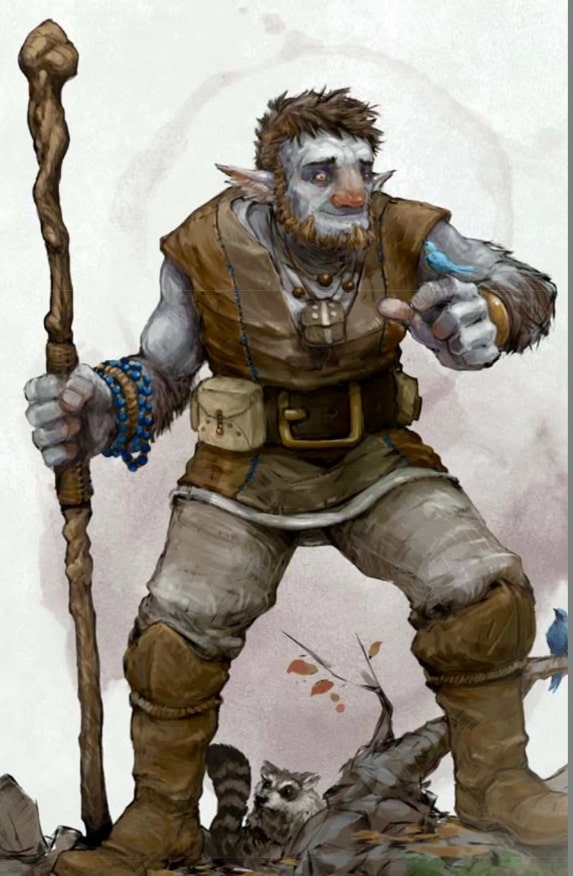
A Firbolg (pictured here, Volo's Guide to Monsters) sets out into nature, away from his tribe, to explore.
Firbolgs are giantkin, and in certain lore are fey-touched as well in their lineage. They live in tight knit tribes and are often connected to nature. For mechanical analysis, , I am referring to the Mordenkainen Presents: Monsters of the Multiverse Firbolg. They are only slightly compatible with the class, with beneficial ability score improvements and bonus spells that allow you to use Charisma (the Paladin’s casting ability) as the casting ability associated.
Firbolgs are really only generically compatible. If you are looking for a race to play as an introduction to the class, they are perfect because they do not add too many overwhelming mechanics on top of learning a brand new class. They also get an invisibility ability that can be beneficial in combat and give you spells that would rely on your Charisma.
Choose Firbolg if:
- You are new to playing the Paladin class
- Firbolgs do not have a lot of overly complicated mechanics. The simplicity of Firbolgs can allow you to focus on learning the Paladin class without extra complicated abilities added in to the mix
- You are looking for a more customizable race
- Firbolgs get ability scores that do not go to specific abilities, so you have more control over how your mechanics are customized
- You are not the only front line man
- The invisibility that Firbolgs get is best used when you not being able to be seen be the enemy does not leave the rest of your party completely exposed without you
- You are building a Strength based Paladin
- The nonspecific ability score improvements can be used to increase your Strength and lean into a Strength based build. Firbolgs also count as Large for carrying capacity and the weight you can pull, drag and lift, and coupling that with a high Strength can make them a very effective Strength based Paladin
- You are playing in a roleplay heavy campaign
- Firbolgs come from tight knit clans, which gives them a lot of in world connections and a possible safe place for the party. This is really good in roleplay campaigns, which often prioritize NPC-PC connection
Firbolg bonuses:
- You get a +2 and +1 to two different ability scores, or you can increase three by a +1
- Natural access to the Detect Magic and Disguise Self spells with the ability to use Charisma as the casting ability, as a Paladin build should prioritize the Charisma stat
- The ability to use your bonus action in combat to go invisible until the start if your next turn as long as you do not attack, deal damage, or force a saving throw
- Counting as one size larger (Large) for carrying capacity and the weight you can pull, drag and lift
8) Kalashtar (good)
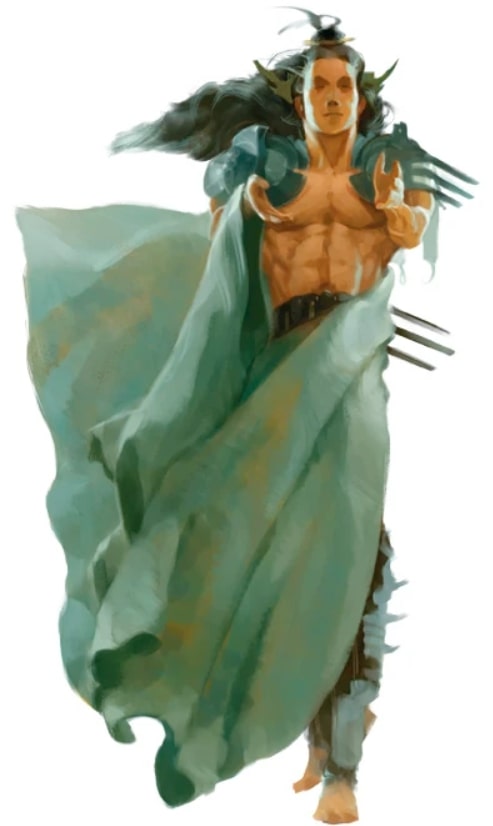
Kalashtars (pictured here, Eberron) are a race tied to the Plane of Dreams because of their unique ancestry.
Kalashtar are from the Eberron - Rising from the Last War, but I have seen them used in other settings. They were created by the union of humanoids and spirits from the Plane of Dreams called Quori. They are often seen as very wise by others, but are followed and haunted by the conflicts of the Quori attached to them. Kalashtar are another slightly compatible race.
Kalashtars are slightly compatible overall for the Paladin class. They are the best option for Paladins that come from the Eberron setting, but they are another race that is better for multiclassing and mostly beneficial for lore reasons. They have general useful abilities which is why they are 8 on the list and not lower.
Choose Kalashtar if:
- You are playing a Paladin in the Eberron setting
- Kalashtar is the best race option for Paladins in the Eberron setting. They have a unique connection to the lore of the setting and have lots of reasons to swear oaths, as well as abilities that can benefit the Paladin class
- You are playing in a magic heavy campaign
- Kalashtars are resistant to psychic damage, which is often caused by spells and magical effects, and they can not be made to dream by magic. This makes them more protected than some of the other races. They would fair well in a magic heavy campaign where enemies are almost guaranteed to be magical
- You are playing a Paladin/Cleric multiclass
- Kalashtars get a beneficial bonus to Wisdom which can help the Cleric aspect of your multiclass as Clerics rely on Wisdom, while still also gaining a Charisma buff that is beneficial for the Paladin class. Charisma is the Paladin’s casting ability
- You are playing in a campaign that heavily involves the planes
- Kalashtars are tied to the Plane of Dreams, which gives your character a tie into the lore of your campaign and can make for more compelling roleplay
- Your campaign involves stealth often
- Kalashtars get an ability to create a telepathic link with a creature you can see, and it will then last for an hour. Paladins are not well designed for stealth but if you have party members who are, you can create a telepathic link with one of them and effectively split the party. If things go south, you can join them as they can communicate directly to you, and you can help execute more complex plans as well, and not have to be tied to your party for fear of miscommunication
Kalashtar bonuses:
- +2 to Wisdom, +1 to Charisma
- Resistance to psychic damage
- Unaffected by spells that require dreaming
- You can create a telepathic link with a creature within 10 times your class level feet as long as they can see you and understand one language
- Whether or not they speak any language you speak does not matter, they will understand you
- The effect lasts for 1 hour
7) Eladrin (good)
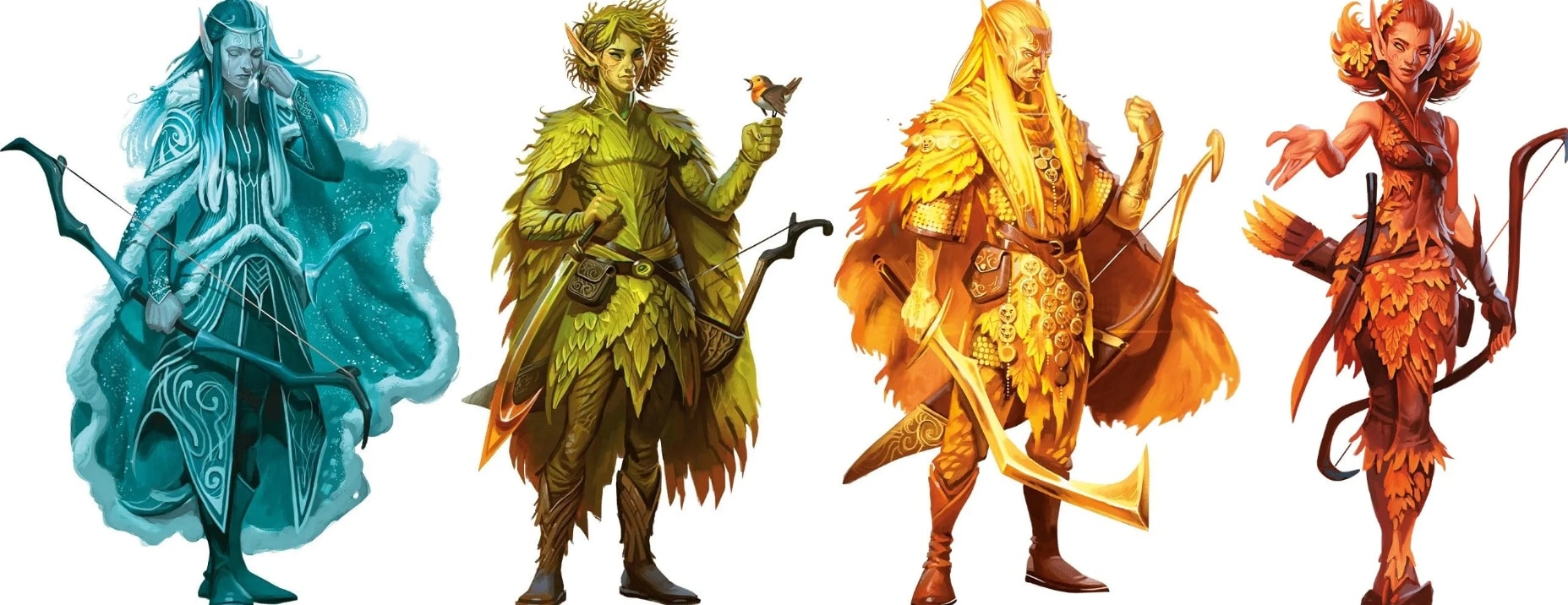
Pictured here are Eladrin (Mordenkainen's Tome of Foes) representing (from left to right) winter, spring, summer and fall.
Eladrin are elves from the Feywild. Their inherent magic from the Feywild manifests itself based on the four seasons - as your appearance and natural magic changes with the seasons. They can also willingly change what season they want their magic to be in once per long rest. Eladrin are only somewhat compatible with the class as a whole, but have a better magic ability that is more useful in combat, placing them above Firbolgs and Kalashtar.
Eladrin are somewhat compatible with the Paladin class. They get nonspecific ability score improvements that you can use to tailor your ability scores to fit the class. They are also more protected against certain magical effects and can help you deal more damage, which Paladins are known to be very good for. However they do not have enough abilities that are good specifically for the Paladin class to be higher on the list, so they come in at seven.
Choose Eladrin if:
- You are playing a Paladin in a campaign that takes place within the Feywild
- As Eladrin are the elves of the Feywild, this would give you a good tie into the lore and setting of your campaign and provide you with a way to navigate the setting in character
- You are playing in a magic heavy campaign
- Eladrin cannot be put to sleep with magic and they have advantage against being charmed, which makes them more protected against certain magical effects and magical enemies than other races
- You are playing in a combat heavy game
- Eladrin have a magical ability that changes with what season they represent. It is very good for combat and managing multiple enemies. The ability can also cause different magical effects and can deal extra damage depending on what season the Eladrin represents which is good for combat
- Plane hopping is common in the campaign
- Eladrin already do not come from the Material Plane, so it would tie you into the functioning of your campaign and give you a way to navigate it in character
- You want to increase your damage output
- Eladrin, when they represent summer, can use their Fey Step (teleportation) ability to also deal extra fire damage, which would increase your average damage output
Eladrin bonuses:
- +2 to one chosen ability score and +1 to another, or +1 to three chosen ability scores
- Darkvision
- Advantage on saving throws against charm magic
- Bonus action to teleport to an unoccupied space up to 30 ft away (Fey Step)
- Number of uses equal to proficiency bonus
- After 3rd level, it gains an additional ability based on the season you have chosen to embody
- Autumn - immediately after you use Fey Step, 1-2 creatures within 10 feet of you that you choose must succeed on a Wisdom save or be charmed
- The effect lasts for a minute or until your allies or you deal damage to them
- Winter - when you use Fey Step, one creature within 5 feet of you has to make a Wisdom save successfully or be frightened of you
- This effect lasts until the end of your next turn
- Spring - when you use Fey Step, you can touch a willing creature within 5 ft of you, and they can teleport instead of you up to 30 ft in a space you choose
- Summer - immediately after you use Fey Step, every creature you choose within 5 ft of you takes fire damage equal to your proficiency bonus
- Autumn - immediately after you use Fey Step, 1-2 creatures within 10 feet of you that you choose must succeed on a Wisdom save or be charmed
- Natural Perception proficiency
- No need to sleep
- Your long rest is instead a 4 hour trance where you still have consciousness
- During this trance you can change the season you embody and gain two new tool and/or weapon proficiencies that last until the next long rest
- Magic cannot put you to sleep
6) Jerbeen (good)
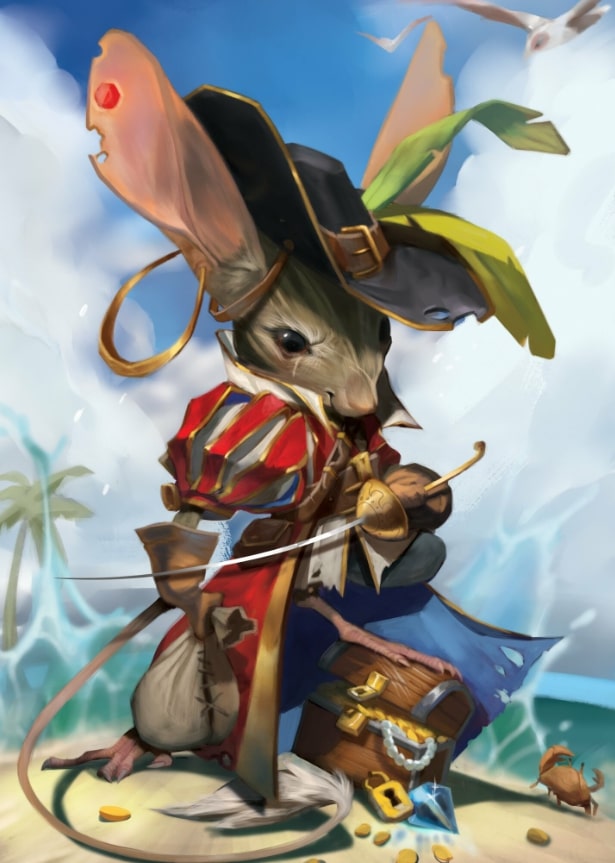
Pictured here is a swashbuckling Jerbeen (Humblewood). Although they may be small in size, they are fierce!
Jerbeen are a mouse-like race from the Humblewood setting. They are the furthest thing from solitary something could be, living in multigenerational homes and forming their own communities with other Jerbeem. They are dextrous and charismatic, which makes them somewhat compatible with the Paladin class.
Jerbeen are somewhat compatible for the Paladin class. They have great lore based qualities that make them perfect to take a magic creating oath, get a useful buff to Dexterity and Charisma, which can both be useful to Paladins, and have a few useful abilities that can be good in combat. However, the do not have anything that increases their damage output or their magical performance, which lands them at six.
Choose Jerbeen if:
- You want to play a godless Paladin
- Jerbeens are very dedicated to community and their loved ones, which could be a very compelling reason to take an oath if you do not want to make an oath to a god. If you want to play a non-religious/godless Paladin, Jerbeens’ cultural values could be the reason for your oath instead
- You are playing a Paladin in the Humblewood setting
- Jerbeens are a good option for the Humblewood setting, as they have some useful combat abilities and a lot of lore that would point them in the direction of Paladin, such as their dedication to community
- You are playing a Dexterity based Paladin
- Jerbeens get a good buff to Dexterity, which could allow you to lean into Dexterity being your useful physical stat for the martial aspect of Paladins
- Your DM allows unique races in their settings
- Jerbeens come from the Humblewood setting, but they do not have to be played just in the Humblewood setting. If your DM encourages unique races, Jerbeen is a good option for Paladins if you are looking to play something fun and new
- You are not the only front line man
- Jerbeens get an ability that allows you to get advantage on Strength saving throws and saving throws against being frightened if you are within 5 ft of an ally (who is not incapacitated or frightened). If you have another front line man (Paladins often are front line men on their own), you can stick close to them and get to use this ability, which also means at least one ally would be benefiting from your Paladin auras at the same time
Jerbeen bonuses:
- +2 to Dexterity, +1 to Charisma
- Base long jump is 30 ft and base high jump is 15 ft with or without a running start
- You can pass through the space of any Medium or larger creature
- Advantage on Strength saving throws and saving throws against being frightened if you are within 5 ft of an ally
- The ally must not be incapacitated or frightened and you must be able to see and hear them
- The help action is a bonus action for them
5) Luma (good)
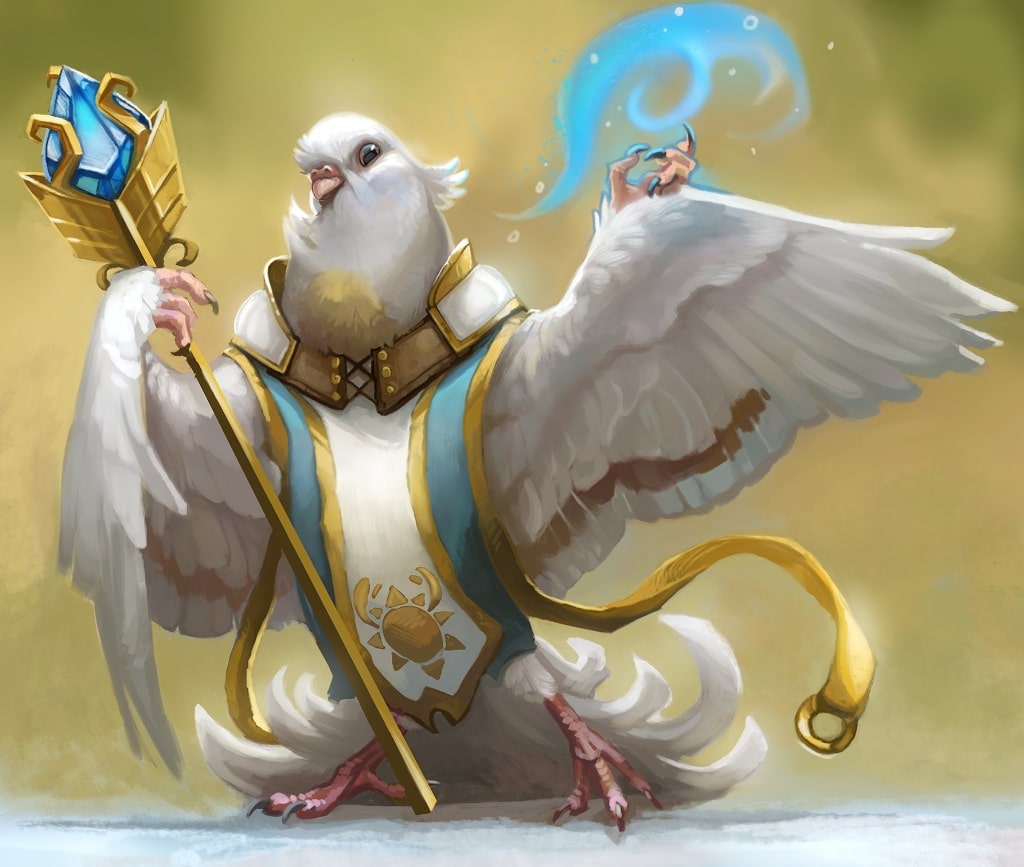
Pictured here is a Luma priest (Humblewood) displaying a magical skill. They are eccletic, and often find themselves in religious spaces!
Lumas are pigeon or dove-like birdfolk from the Humblewood setting. They are known for being eccentric, and within Humblewood lore they can be shunned or highly celebrated for their eccentricity in equal amounts. There are also two subraces you get to choose from that help you build a sturdier character or a wiser character. Lumas are compatible with the Paladin class.
Lumas are compatible with the Paladin class. They get a Charisma buff and two good subrace options that can allow you to build different kinds of Paladins, and playing any Luma lets you get a cantrip, which Paladins do not have access to on their own. However, Paladins are known for carrying heavy weapons and heavy armor, and one of the Luma abilities cannot be used if they are carrying such things, which contradicts with their goodness for the class and places them at 5.
Choose Luma if:
- You want to increase your tankiness
- Paladins are often played as tanks (characters who can absorb heavy amounts of damage), and the Sable subrace gives you a small buff to Constitution which could potentially make you more of a tank with more HP to spare to absorb the damage for your squishier party members
- You are playing a Paladin in the Humblewood setting
- Lumas are the best option for Paladins within the Humblewood setting, as they get good combat abilities, increase the tank abilities you have and help with your magic
- You are playing a Paladin/Cleric multiclass
- The Sera subrace provides a Wisdom bonus that is helpful for the Cleric class, but they also have Charisma based abilities which Paladins are good at
- You want to increase your spell list
- The Sera subrace gives you access to the Charm Person spell
- You are playing in a roleplay heavy campaign
- Luma are eccentric and interesting within their lore. They have a lot of strange and unique traits that can be fun to lean into and utilize in a campaign that prioritizes roleplay
Luma bonuses:
- +2 to Charisma
- The ability to glide
- Takes a reaction after you begin falling
- You then gently fall at a speed of 60 ft a second and take no fall damage when you land
- If you fall at least 10 ft in the glide, you can fly up to your movement to land in space of your choosing, you just cannot go up
- This ability is not usable while you carry heavy weapons or hold a shield (though you can drop them as part of your reaction), or while wearing heavy armor or encumbered
- As a bonus action you can propel yourself up to half your movement speed with your feathered arms
- You can use it with a normal jump
- You get a cantrip from the sorcerer spell list
- You use Charisma as your spellcasting ability
- Sable subrace
- +1 to Constitution
- Everyone who rolls insight against you they have disadvantage, and you have advantage on deception against anyone who is not a Luma
- Advantage on saving throws against poison
- Resistant to poison damage
- Sera subrace
- +1 to Wisdom
- Natural proficiency in performance
- Natural ability to cast the Charm Person spell once per long rest
- Does not require somatic components
- Charisma is the ability it uses
4) Triton (good)
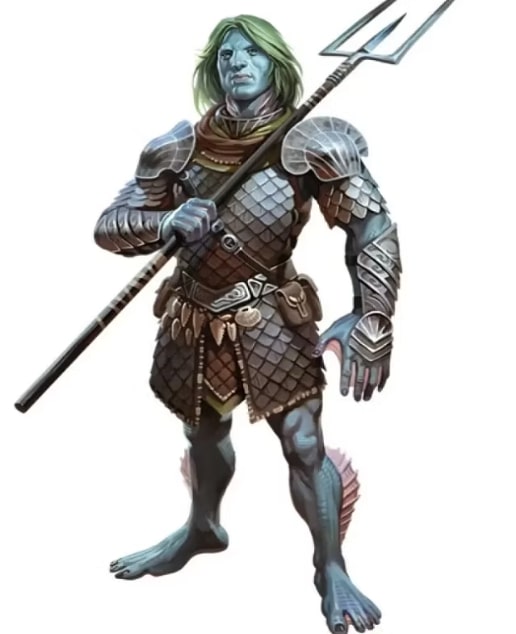
This Triton (pictured here, Volo's Guide to Monsters) looks armed and ready to take on foes above and below the ocean.
Tritons are folk with fishlike traits. In Volo's Guide to Monsters canon, they are protectors of the oceans. They make small settlements near dangerous areas to guard the depths of the oceans, but have slowly become interested in the world on dry land. Tritons are compatible with the Paladin class.
Tritons are compatible with the Paladin class. Their ability score bonuses are useful for the class across the board, they have a damage resistance which is good when this class is often played as a front line man, and their natural magic expands the spell list you can have. However you do not really get increases to the damage you could do, which is a big important thing for Paladins. You also do not get any natural access to cantrips which would be useful, which makes them come in at 4 and not higher.
Choose Tritons if:
- You are playing in a travel heavy campaign
- Tritons get Darkvision, which is often useful in travel heavy campaigns due to the fact that you will spend a good amount of time outside in the dark. It will make it easier for you to handle combat, and successfully keep watch when you travel
- You want to increase your spell list
- Tritons get access to three different spells as you level up that do not require spell slot expenditure, which is beneficial because half casters get less spell slots than their full caster counterparts
- You are playing in a magic heavy campaign
- Tritons are resistant to cold damage, which a kind of damage which is done by spells and magical effects
- You want to play a Strength based Paladin
- Tritons get a slight buff to Strength, which can be enough to help solidify a Strength based Paladin build by improving the ability score
- You want to increase your hit points
- Tritons also get a slight Constitution buff, which can help increase your Constitution modifier which will increase your hit point total as you level up
Triton bonuses:
- +1 to Strength, Constitution and Charisma
- Swimming speed of 30 ft
- Ability to breathe air and water
- Natural ability to cast Fog Cloud
- At level 3 you can also cast Gust of the Wind
- At 5th level you can also cast Wall of Water
- You can only cast each spell once per long rest
- Charisma is the casting ability
- Darkvision
- You can communicate simple ideas with water breathing beasts, but have no special ability to understand them back
- Cold damage resistance
3) Half-Elf (great)
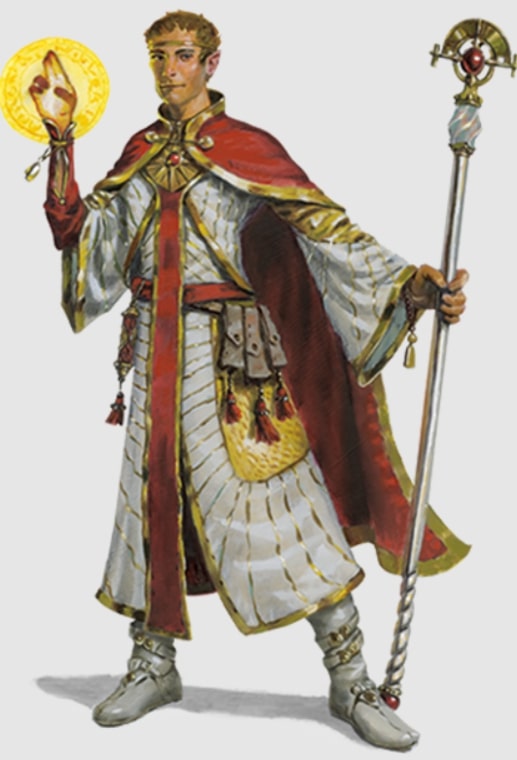
This Half-Elf (Wizards of the Coast) seems to be priestly in nature, like a lot of Paladins often are.
Half-Elves are generally the offspring of Elf and Human parents, although I have seen some play Half-Elves with Orc, Dragonborn, Triton, etc. parents instead of Human, but you may need to make a homebrew race for that. You gain a lot of the Elf benefits, but have more variety within your backstory. Half-Elves have a lot of great abilities, and are very charismatic which makes them very compatible with the Paladin class.
Half-elves are very compatible with the Paladin class. They do not have a lot of racial bonuses but they do get a good Charisma buff, and you can use the open ability score improvements to increase your physical abilities which are very necessary for Paladins. You are also more protected against magical effects, and the various options you get for the Skill Versatility trait can be used to benefit your Paladin build. However, they do have less racial bonuses than others on this list which places them at 3.
Choose Half-Elf if:
- You want to expand your spell list
- If you have Drow Heritage, you can select an ability that gives you access to a cantrip and three spells that do not need spell slots to be used. This is very beneficial for half casters as established earlier in the article
- You want access to cantrips
- There are two options for an ability that can give you access to cantrips, which Paladins do not otherwise get
- You are playing in a magic heavy game
- Half-Elves cannot be put to sleep with magic and they get advantage on saving throws against being charmed. This protects them more than average races against magical effects and enemies
- You have a good Intelligence stat
- The cantrip option for Skill Versatility uses Intelligence as the casting ability, and if you have good Intelligence this option is more beneficial to you
- You are in a travel heavy campaign
- Darkvision helps in travel campaigns, as you will often spend a lot of time in the dark in travel heavy campaigns. You can fight without disadvantage and successfully keep watch
Half-Elf bonuses:
- +2 to Charisma and +1 to two other ability scores
- Darkvision
- Advantage against being charmed and you cannot be put to sleep with magic
- You get to choose a language to know on top of Common and Elvish
- An ability called Half-Elf Versatility that allows you to choose one of these abilities
- Skill Versatility - you get proficiency in two skills of your choice
- Elf Weapon Training - gain proficiency in longsword, shortsword, shortbow, and longbow.
- You must have High Elf heritage
- Cantrip - you learn a cantrip from the wizard spell list
- Intelligence is your casting ability
- You must have High Elf heritage
- Fleet of Foot - you get a base walking speed of 35 ft
- You must have Wood Elf heritage
- Mask of the Wild - you can make attempts to hid even if you are only obscured by natural phenomenon such as heavy rain
- You must have Wood Elf heritage
- Drow Magic - you get the Dancing Light cantrip, at 3rd level you get access to the Faerie Fire spell, and then at 5th level the Darkness spell
- You can only cast each spell once per long rest
- Charisma is your spellcasting ability
- You must have Drow/Dark Elf heritage
- Swim Speed - you get a swimming speed of 30 ft
- You must have Aquatic Elf heritage
2) Tiefling (great)
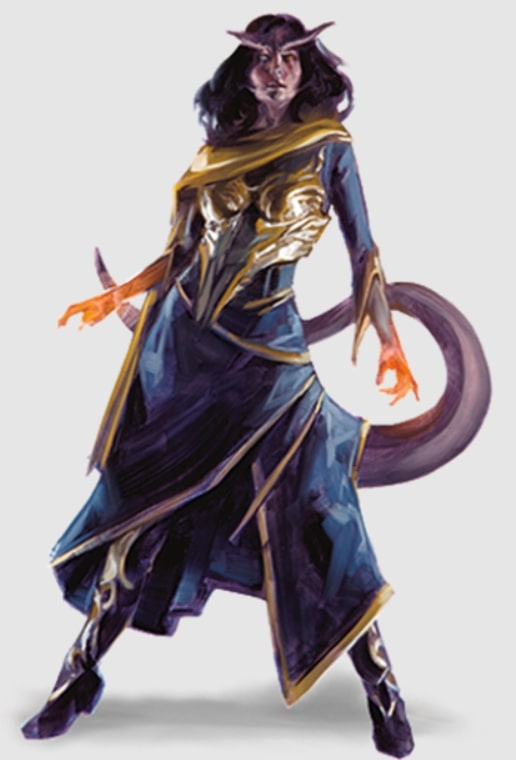
This Tiefling (pictured here, Player's Handbook) displays her Infernal ancestry with her horns, tail, and purple skin.
Tieflings are the product of bloodlines touched by devilish pacts. They are infernal in appearance and their natural abilities come from their ancestral connection to Asmodeus. They are charismatic, inherently magical, and very skilled in many things. This makes them very compatible for the Paladin class.
Tieflings are very compatible with the Paladin class. They get a Charisma buff, use Charisma for their natural magic casting, have compelling possibilities for in campaign lore h, and they get access to a cantrip Paladins otherwise would not get. These things place them at number two.
Choose Tiefling if:
- You are playing in a magic heavy campaign
- Tieflings are resistant to fire damage, which is an effect often done by spells and magical effects. This resistance makes you more protected in magical campaigns than other races
- Your campaign heavily involves religion
- Tieflings can have very compelling arcs, especially as a Paladin, when dnd religion is involved. They can be pulled in different directions by their Infernal bloodline and their oath
- You want to access to a cantrip
- You get access to the Thaumaturgy cantrip, which can be very beneficial in a lot of situations, and you otherwise wouldn’t get it as Paladins do not get cantrips as a part of their class
- Your Charisma needs a boost
- You get a good buff to your Charisma ability score , which will greatly help your spellcasting as a Paladin
- You want to expand your spell list
- Tieflings get access naturally to two spells that do not require spell slot usage, which is very beneficial to half casters as they do not have as many spell slots as full casters
Tiefling bonuses:
- +2 to Charisma
- Darkvision
- Resistance to fire damage
- Bloodline of Asmodeus
- +1 to Intelligence
- You get the Thaumaturgy cantrip, then at 3rd level you get access to the Hellish Rebuke spell, and then at 5th level access to the Darkness spell
- You can cast them each once per long rest
- Charisma is your spellcasting ability
1) Aasimar (best)
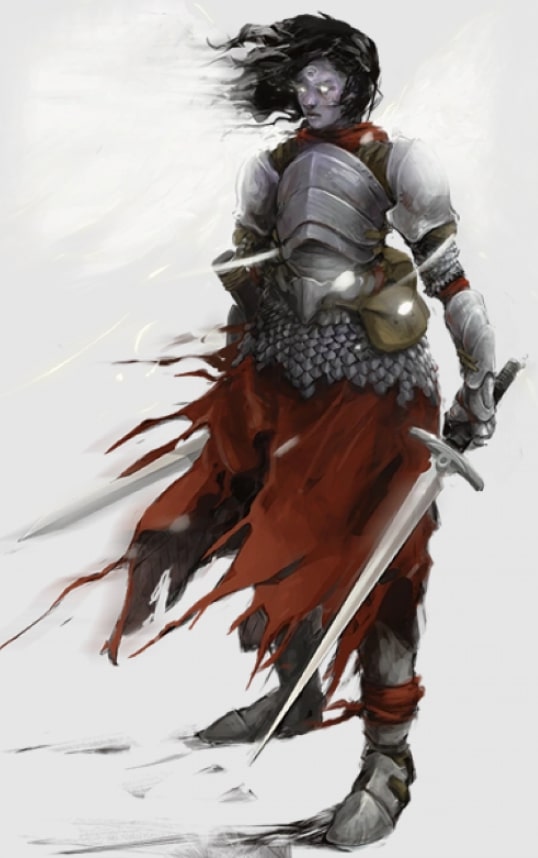
The glowing eyes, forehead marking and grey skin are indicative of an Aasimar (pictured here, Wizards of the Coast). She is dressed in heavy armor and looks like she could make a fine Paladin.
Aasimar are practically the polar opposite of Tieflings. Within the context of Volo's Guide to Monsters, Aasimar are the product of a bloodline blessed by lawful good deities. They are seen as holy, and often serve as god champions. They are naturally charismatic, have three (official) subraces to choose from, and are a great option to tie in your backstory to your mechanics. Aasimar are the most compatible race for the Paladin subclass.
Aasimar are the most compatible with the Paladin subclass. They get a Charisma buff as the base racial ability score improvement and two of their subraces can help the physical aspect of Paladin builds. Aasimar are also great for damage output. They are also good for developing your backstory and your reason for your oath, and they protect you from certain magical damages. All these things combined are why they are number one.
Choose Aasimar if:
- You want to play a Strength based Paladin
- The Fallen subrace that you can pick buffs your Strength, which can help you lean into a Strength based Paladin build
- You want to increase your damage output
- Each Aasimar transformation can allow you to deal extra damage once per turn, which can also save your spell slots as you will not need to use Smite as often to deal extra damage
- You want your oath to be serving a god
- Aasimar have backstories directly tied to the god that blessed their bloodline. That would give them a reason to be a Paladin in service of a god. They are often selected as champions, and your arc and backstory could revolve around that
- You want to increase your tankiness
- Scourge Aasimar get a buff to their Constitution, which can increase the numbers you can get to increase your hit point maximum as you level up
- You want to play an Oathbreaker Paladin
- Fallen Aasimar can give compelling reasons to play an Oathbreaker as they have clearly left their god’s good graces. That can be an interesting way to tie your mechanics into your lore
Aasimar bonuses:
- +2 to Charisma
- Darkvision
- Resistance to necrotic and radiant damage
- You can give a creature healing equal to your level
- Takes an action
- Can only be used once per long rest
- You know the Light cantrip
- Charisma is your spellcasting ability
- Three subraces
- Protector
- +1 to Wisdom
- Beginning at 3rd level, you can use an action to give yourself incorporeal wings
- Transformation lasts for a minute (or until you end it as a bonus action)
- You gain a flying speed of 30 ft
- On one attack per turn you make that hits while transformed deals extra radiant damage equal to your level
- Can only be used once per long rest
- Scourge
- +1 to Constitution
- Beginning at 3rd level, you can use an action to cause light to radiate from you that damages those around you, and even threatens you
- Transformation lasts for a minute (or until you end it as a bonus action)
- While transformed you radiate a 10 ft radius of bright light, and an additional 10 ft radius of dim light
- At the end of each of your turns, any creature within 10 ft of you (and you) take radiant damage equal to half your level rounded up
- Once per turn, you can also deal extra radiant damage equal to your level when you attack a creature successfully
- You can only use this ability once per long rest
- Fallen
- +1 to Strength
- Starting at 3rd level, you can use an action to transform and cause skeletal (flightless) wings to sprout from your back
- As soon as your transform, every creature within 10 feet of you must make a Charisma saving throw against your DC (8 + proficiency bonus + Charisma modifier) or be frightened of you until the end of your next turn
- Transformation lasts a minute (or until you end it as a bonus action)
- Once per turn, you can deal extra necrotic damage equal to your level when you successfully attack a creature
- You can only use this once per long rest
- Protector
You may also be interested in:
- The Best D&D Classes (Ranked from Worst to Best)
- Top 25 Best D&D Villains of All Time
- 32 Most Interesting Facts About Dungeons and Dragons!
- 25 Best D&D Games for PC That Every Fan Must Play!
- The 10 Best DnD Streams
- Most Powerful D&D Dragons For Adventurers To Defeat
- Top 10 Best DnD Campaign Ideas
- Top 5 DnD Most Useful Languages
- D&D Top 10 Most Damaging Spells That Obliterate Foes
- Top 15 Most Powerful D&D Spells
- The Best D&D Race for Every Class

